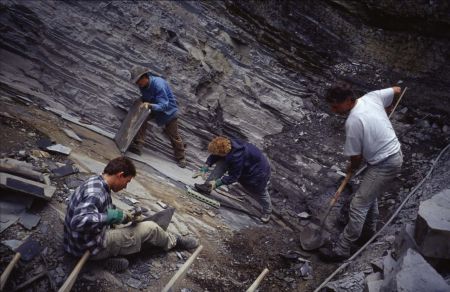University of Zürich
Paläontologisches Institut und Museum der Universität Zürich
From 1994 to 2005, time-limited fossil excavations were carried out at different locations within the Meride Limestone. These excavations were conducted under the direction of Heinz Furrer and in cooperation with the Museo cantonale di storia naturale di Lugano. The material excavated from the Kalkschieferzone of Val Mara near Meride in 1994 has been prepared and scientifically described (Bürgin 1995: fish; Furrer 1995: stratigraphy, facies and palaeoecology). It is now housed in the Museo cantonale di storia naturale di Lugano.
Material from excavations in 1995 and 1996 in the Cava inferiore beds, and between 1997 and 2005 in the Cava superiore beds of Acqua del Ghiffo near Crocifisso is far more extensive. While the majority of specimens have been prepared, the material has not yet been fully studied. However, some results of detailed stratigraphic, sedimentological, facies, taphonomic and palaeoecological studies have been published by Furrer (1999), Bürgin (1999) described the new fish discoveries and Hänni (2004) the remains of a juvenile Ceresiosaurus calcagnii. The remaining fossils are still being processed, including examples of Neusticosaurus, Ceresiosaurus, other fish, crustaceans, bivalves, gastropods, calcareous algae, insects and land plants. The most visually attractive objects to date are displayed in the Museo cantonale di storia naturale di Lugano or in the Museo dei fossili in Meride.
Since 1998, some fossil groups from the old collections of the University of Zurich have been re-studied in terms of their morphology and histology. For example, the fish: Acrodus georgii (Mutter 1998), Colobodontidae (Mutter 2004), Birgeria stensioei (Romano & Brinkmann 2009), Eosemionotus ceresiensis (Bürgin 2004), Saurichthys (Wilson et al. 2013, Maxwell et al. 2013, 2015, Scheyer et al. 2014, Argyriou et al. 2016) and Ticinolepis (López-Arbarello et al. 2016); the reptiles: Mixosauridae (Brinkmann 1998, 2004), Mixosaurus (bone histology, Kolb et al. 2011, Houssaye et al. 2014), Ceresiosaurus (Hänni 1998, 2004), Nothosauridae and Pachypleurosauridae (bone histology, Hugi et al. 2011, 2012), Askeptosaurus (Müller 2005), Cyamodus (Scheyer 2010) and Rauisuchia (Scheyer & Desojo 2011). Additionally, taphonomic studies on Pachypleurosauridae (Beardmore et al. 2012, Beardmore & Furrer 2016), ichthyosaurs (Beardmore & Furrer 2015) and Tanystropheus (Beardmore & Furrer 2017), an animation of the function of a conodont apparatus (Goudemand et al. 2011) as well as a study regarding the bivalve genus Daonella (Schatz 2005) have been undertaken. Other related projects have investigated sedimentology and palaeoecology (Röhl et al. 2001), and stable isotopes (Sharp et al. 2000).
The Zurich University team working at Acqua del Ghiffo, directed by Heinz Furrer. (photo H. Furrer, 2001)






